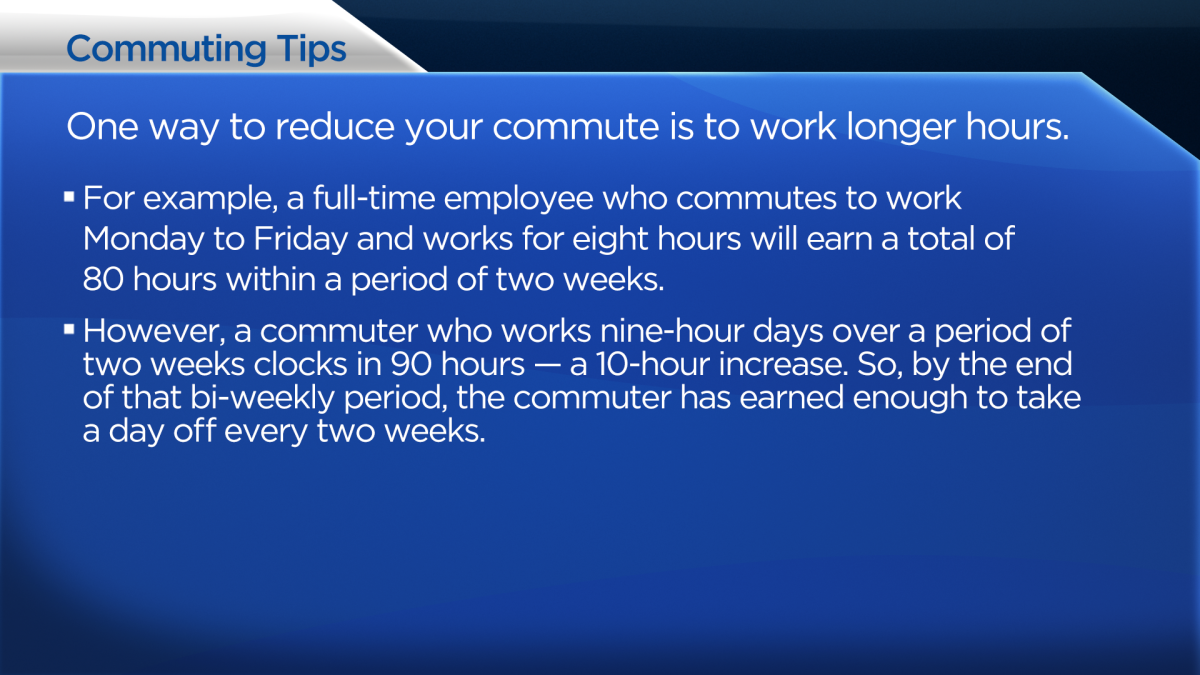There is nothing like 9 a.m. traffic on a Monday morning.

Commuting is a part of life for most Canadians. While many believe public transit and driving are the only practical means of getting to work, there are other options as well as ways to cut back on your commuting time.
According to Statistics Canada, 78 per cent of Canadians travel to work by car as either a driver or a passenger, and on average, they spend 24 minutes commuting to work. One in five Canadians has a carpooling commute of at least 60 minutes.
On Wednesday, a StatCan study comparing commute times from 1996 and 2016 revealed that commuting time in Toronto has increased by six per cent. In 1996, the percentage of Canadians who worked more than 25 kilometres from their workplace was 20 per cent, but in 2016, it was 26 per cent.
READ MORE: Toronto ranked worst city for commuting in North America, study says
Here are some ways you can cut your commute time:
1. Biking to work
In Toronto, biking is a cost-effective option if your daily commute is under 30 minutes.
Mike Layton, a Toronto city councillor, says biking to work cuts down commuting time and helps the city with active transportation. Over the years, Layton and another councillor, Joe Cressy, have helped many downtown residents by developing new bike lanes to promote cycling to work.
Layton has never owned a car and has always lived near work.
“I cycle to work most days,” Layton says. “In the winter, when it’s snowing, there are a limited number of days when I don’t bike. And it has to be really snowing.”
Can-Bike, a cycling program provided by the city, also helps newcomers learn how to cycle.
According to Layton, commuters say they drive or take public transit because either they’re not comfortable on a bike or their workplace is too far from their home.
“We have programs in the city that can help with that,” he says.
Vancouver leads the country in biking to work. StatCan reports that 2.3 per cent of Vancouver’s population bikes to work, but only 1.4 per cent of commuters cycle in Toronto.

Get breaking National news
Pete Fry, a Vancouver city councillor, believes that cycling is a good way to commute in the city.
“Cycling within Vancouver city is a practical and popular mode for commuting,” he says.
The City of Vancouver says cycling is also a time-saver as 45 minutes of walking is equal to 15 minutes of biking. Bike maps are offered on the city’s website.
READ MORE: New separated bike lane for downtown Vancouver on the table
2. Working longer hours
Working longer hours may seem stressful, but there can be a reward: depending on your employer, if you choose to work longer hours, you may be able to bank enough time to take an extra day off.
For example, a full-time employee who commutes to work Monday to Friday and who works for eight hours a day can clock up to 80 work hours over a two-week period.
Yet a commuter who works nine-hour days over that same two-week period can bank 90 hours — a 10-hour increase. So, by the end of that two-week period, the commuter will have accumulated enough time to take an extra day off.
3. Take toll roads
If you live far from your workplace, using toll roads can cut down on your commuting time. You will have to pay, but the price may be worth it for the time saved.
Elliott Silverstein, manager of government relations at the Canadian Automobile Association in South Central Ontario, said highways such as Ontario’s 407 toll road are an option.
“Congestion is very time-consuming and very costly so toll roads may be the option, and we only have one in Ontario — the 407 — right now,” Silverstein says. “It may save a few minutes on their daily commute.”
READ MORE: Self-driving vehicles could clog Canada’s streets, experts warn
4. Working from home
Some employers will let employees work from home one day a week. This helps with those who have kids or dependents they have to take care of so it is less stressful.
One in four employees reported to Statistics Canada that they work from home. Workers who are over the age of 25 were those most likely to work from home. StatCan also reported that workers in management are most likely to work from home.
The bottom line is that when you work from home, it’s possible to make better use of the time you would otherwise spend commuting to work.
WATCH (June 4, 2018): Why Ontarians are in desperate need for a fix to congestion and transit problems

5. Working on the go
Some jobs require you to travel around a lot, but that can give workers a chance to finish their tasks during their commute.
Statistics Canada reports that 11.6 per cent of Canadians don’t have a fixed workplace since their jobs require them to travel frequently, and working on the go can be a handy alternative.
Many bus stations allow you to connect to wireless internet so you can complete your tasks while waiting for your ride.
If you need to find someplace to work for a longer stretch of time than it takes for your bus to arrive, community centres and libraries offer access to free Wi-Fi, and there is no time limit for your stay.
Ed. note – This story has been updated to correct the average percentage of Canadians who travel to work by car.








Comments